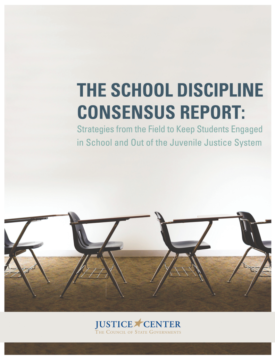School Discipline Consensus Report
Resource type: Research Report
The Council of State Governments Justice Center |
The research and data on school discipline practices is clear: Millions of students are removed from their classrooms each year, overwhelmingly for minor misconduct. We can’t allow this trend to continue. Addressing staggeringly high suspension rates is essential to making school a place where students feel safe and teachers want to work. Reducing suspension rates benefits the entire school community. It should be part of any effort to improve graduation rates, to close the achievement gap and to keep kids out of the juvenile justice system.
In keeping with this forward-looking approach, The Council of State Governments (CSG) Justice Center has released the School Discipline Consensus Report, a massive catalog of promising strategies for reforming school discipline. The report draws on diverse insights from the fields of education, health, law enforcement and juvenile justice and offers a consensus framework to address these problems. The study also highlights proven examples of reform in action, from Baltimore to Denver to Austin.
The CSG Justice Center’s report recommends addressing discipline through improving the overall learning climate in the school, rather than addressing the way that specific types of misconduct should be handled. When students don’t feel supported or engaged in school, they are more likely to act up in the first place. If a teacher feels his or her only option is to remove a child from class, the resulting impact on the learning environment is inevitable; if children feel that the discipline system is punitive and unfair, they’ll distrust it and have little respect for its provisions.
Among the many recommendations included, the report suggests the following strategies:
- Ensure that students removed from the classroom for disciplinary reasons continue to receive quality instruction.
- Train, supervise and evaluate school-based police officers.
- Take steps toward reducing school referrals to the juvenile justice system, including collecting data around the circumstances of those referrals.
- Collect data on students who require targeted behavioral interventions.
- Establish clear roles of school-based police officers to ensure the safety and comfort of all students.
These strategies have already had a significant impact in school districts across the nation. For example, in New York City, as a result of some initial steps to revise disciplinary practices, school suspensions were reduced by 23 percent between 2012 and 2013 and school-based arrests were down 30 percent over the same period. Communities and officials in New York City continue to work on improving school climate and discipline, including undertaking efforts to reduce disparities in school discipline, which have remained high for students of color and students with disabilities.
The recommendations included in the report are invaluable in not only providing strategies for reform, but in showing examples of these strategies in action. Though there may not be a one-size-fits-all solution to addressing the disparities in school discipline, these recommendations, combined with a dedicated effort from policymakers and school officials, can ensure a better learning environment while equipping all students for success.
Learn More
> School Discipline Consensus Report website
In the Media
> Schools Get Road Map for Improving Discipline Practices, The Washington Post, 3 June 2014
> Taking Aim at School Suspensions, The Wall Street Journal, 3 June 2014
The Council of States Governments Justice Center is a grantee of Atlantic’s Children & Youth programme in the United States, which funds efforts to reform school discipline policies.
